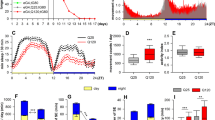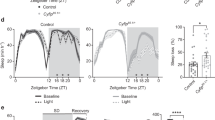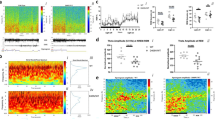Abstract
Familial advanced sleep phase syndrome (FASPS) is a human behavioural phenotype characterized by early sleep times and early-morning awakening1. It was the first human, mendelian circadian rhythm variant to be well-characterized, and was shown to result from a mutation in a phosphorylation site within the casein kinase I (CKI)-binding domain of the human PER2 gene. To gain a deeper understanding of the mechanisms of circadian rhythm regulation in humans, we set out to identify mutations in human subjects leading to FASPS. We report here the identification of a missense mutation (T44A) in the human CKIδ gene, which results in FASPS. This mutant kinase has decreased enzymatic activity in vitro. Transgenic Drosophila carrying the human CKIδ-T44A gene showed a phenotype with lengthened circadian period. In contrast, transgenic mice carrying the same mutation have a shorter circadian period, a phenotype mimicking human FASPS. These results show that CKIδ is a central component in the mammalian clock, and suggest that mammalian and fly clocks might have different regulatory mechanisms despite the highly conserved nature of their individual components.
This is a preview of subscription content, access via your institution
Access options
Subscribe to this journal
Receive 51 print issues and online access
$199.00 per year
only $3.90 per issue
Buy this article
- Purchase on Springer Link
- Instant access to full article PDF
Prices may be subject to local taxes which are calculated during checkout



Similar content being viewed by others
References
Jones, C. R. et al. Familial advanced sleep-phase syndrome: A short-period circadian rhythm variant in humans. Nature Med. 5, 1062–1065 (1999)
Dunlap, J. C. Molecular bases for circadian clocks. Cell 96, 271–290 (1999)
Edery, I., Zwiebel, L. J., Dembinska, M. E. & Rosbash, M. Temporal phosphorylation of the Drosophila period protein. Proc. Natl Acad. Sci. USA 91, 2260–2264 (1994)
Denault, D. L., Loros, J. J. & Dunlap, J. C. WC-2 mediates WC-1–FRQ interaction within the PAS protein-linked circadian feedback loop of Neurospora. EMBO J. 20, 109–117 (2001)
Young, M. W. Life's 24-hour clock: molecular control of circadian rhythms in animal cells. Trends Biochem. Sci. 25, 601–606 (2000)
Lee, C., Etchegaray, J. P., Cagampang, F. R., Loudon, A. S. & Reppert, S. M. Posttranslational mechanisms regulate the mammalian circadian clock. Cell 107, 855–867 (2001)
Nawathean, P. & Rosbash, M. The doubletime and CKII kinases collaborate to potentiate Drosophila PER transcriptional repressor activity. Mol. Cell 13, 213–223 (2004)
Sathyanarayanan, S., Zheng, X., Xiao, R. & Sehgal, A. Posttranslational regulation of Drosophila PERIOD protein by protein phosphatase 2A. Cell 116, 603–615 (2004)
Kloss, B. et al. The Drosophila clock gene double-time encodes a protein closely related to human casein kinase Iɛ. Cell 94, 97–107 (1998)
Price, J. L. et al. double-time is a novel Drosophila clock gene that regulates Period protein accumulation. Cell 94, 83–95 (1998)
Martinek, S., Inonog, S., Manoukian, A. S. & Young, M. W. A role for the segment polarity gene shaggy/GSK-3 in the Drosophila circadian clock. Cell 105, 769–779 (2001)
Lin, J. M. et al. A role for casein kinase 2α in the Drosophila circadian clock. Nature 420, 816–820 (2002)
Akten, B. et al. A role for CK2 in the Drosophila circadian oscillator. Nature Neurosci. 6, 251–257 (2003)
Lowrey, P. L. et al. Positional syntenic cloning and functional characterization of the mammalian circadian mutation tau. Science 288, 483–492 (2000)
Preuss, F. et al. Drosophila doubletime mutations which either shorten or lengthen the period of circadian rhythms decrease the protein kinase activity of casein kinase I. Mol. Cell. Biol. 24, 886–898 (2004)
Beck, A. T. The Beck Depression Inventory (Harcourt Brace Jovanich, The Psychological Corporation, San Antonio, 1978)
Dahl, R. E. et al. Sleep onset abnormalities in depressed adolescents. Biol. Psychiatry 39, 400–410 (1996)
Graves, P. R., Haas, D. W., Hagedorn, C. H., DePaoli-Roach, A. A. & Roach, P. J. Molecular cloning, expression, and characterization of a 49-kilodalton casein kinase I isoform from rat testis. J. Biol. Chem. 268, 6394–6401 (1993)
Blau, J. & Young, M. W. Cycling vrille expression is required for a functional Drosophila clock. Cell 99, 661–671 (1999)
Suri, V., Hall, J. C. & Rosbash, M. Two novel doubletime mutants alter circadian properties and eliminate the delay between RNA and protein in Drosophila . J. Neurosci. 20, 7547–7555 (2000)
Heintz, N. BAC to the future: the use of bac transgenic mice for neuroscience research. Nature Rev. Neurosci. 2, 861–870 (2001)
Ralph, M. R. & Menaker, M. A mutation of the circadian system in golden hamsters. Science 241, 1225–1227 (1988)
Shearman, L. P. et al. Interacting molecular loops in the mammalian circadian clock. Science 288, 1013–1019 (2000)
Lee, C., Weaver, D. R. & Reppert, S. M. Direct association between mouse PERIOD and CKIɛ is critical for a functioning circadian clock. Mol. Cell. Biol. 24, 584–594 (2004)
Eide, E. J., Vielhaber, E. L., Hinz, W. A. & Virshup, D. M. The circadian regulatory proteins BMAL1 and cryptochromes are substrates of casein kinase Iɛ. J. Biol. Chem. 277, 17248–17254 (2002)
Phiel, C. J. & Klein, P. S. Molecular targets of lithium action. Annu. Rev. Pharmacol. Toxicol. 41, 789–813 (2001)
Gillin, J. C. The sleep therapies of depression. Prog. Neuropsychopharmacol. Biol. Psychiatry 7, 351–364 (1983)
Toh, K. L. et al. An hPer2 phosphorylation site mutation in familial advanced sleep phase syndrome. Science 291, 1040–1043 (2001)
Vitaterna, M. H. et al. Mutagenesis and mapping of a mouse gene, Clock, essential for circadian behavior. Science 264, 719–725 (1994)
Antoch, M. P. et al. Functional identification of the mouse circadian Clock gene by transgenic BAC rescue. Cell 89, 655–667 (1997)
Acknowledgements
The authors thank the FASPS subjects and their families for participating in this research. We thank U. Heberlein for advice and generous use of fly laboratory facilities, R. Threlkeld for Drosophila injections, and A. Rothenfluh for discussions and support with Drosophila transgenic lines. We also thank M. W. Young and L. Saez for the tim-UAS-gal4 stock and helpful discussions, and S. Reppert for the mouse Per1 clone. We acknowledge J. Cheung, E. Stryker and C. Whitney for technical assistance and members of the Fu and Ptáček laboratories for discussions. R.E.S. is supported by an NIH GCRC grant and the FAHC/UVM Office of Patient Oriented Research. This work was supported by an NIH grant to Y.-H.F. and L.J.P., and a Sandler Neurogenetics grant to Y.-H.F. L.J.P. is an investigator of the Howard Hughes Medical Institute.
Author information
Authors and Affiliations
Corresponding author
Ethics declarations
Competing interests
The authors declare that they have no competing financial interests.
Supplementary information
Supplementary Methods
This file includes additional information on the procedures that were utilized in the study. Supplementary Methods include: mutation screening and testing of controls; cloning, expression and purification of recombinant casein kinase I δ; generation of fly stocks; semi-quantitative RT-PCR for fly heads; engineering of BAC constructs for generating transgenic mice; and generation of CK1 δknock out mice. (DOC 40 kb)
Supplementary Table
This file contains Supplementary Table S1, which shows the results of period length variation from transgenic flies with normal and mutant dbt. (DOC 44 kb)
Supplementary Figure S1
This Supplementary Figure shows the actograms of transgenic flies containing the normal and mutant human CK1δ gene. (DOC 79 kb)
Supplementary Figure S2
This Supplementary Figure details the generation of human CK1δ transgenic mice. (DOC 106 kb)
Supplementary Figure 3
This Supplementary Figure details the disruption of the mouse CK1δ gene. (DOC 100 kb)
Rights and permissions
About this article
Cite this article
Xu, Y., Padiath, Q., Shapiro, R. et al. Functional consequences of a CKIδ mutation causing familial advanced sleep phase syndrome. Nature 434, 640–644 (2005). https://doi.org/10.1038/nature03453
Received:
Accepted:
Issue Date:
DOI: https://doi.org/10.1038/nature03453
This article is cited by
-
DNA polymerase beta connects tumorigenicity with the circadian clock in liver cancer through the epigenetic demethylation of Per1
Cell Death & Disease (2024)
-
Tau reduction attenuates autism-like features in Fmr1 knockout mice
Molecular Autism (2023)
-
Multi-omics profiling reveals rhythmic liver function shaped by meal timing
Nature Communications (2023)
-
Genetics of circadian rhythms and sleep in human health and disease
Nature Reviews Genetics (2023)
-
A domain-relevant framework for the development of face processing
Nature Reviews Psychology (2023)
Comments
By submitting a comment you agree to abide by our Terms and Community Guidelines. If you find something abusive or that does not comply with our terms or guidelines please flag it as inappropriate.



